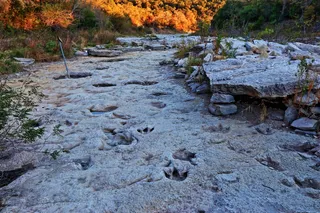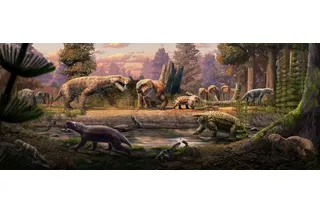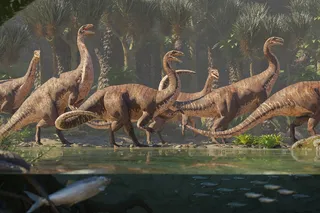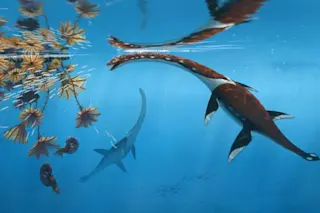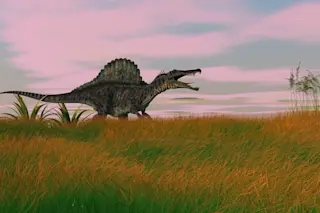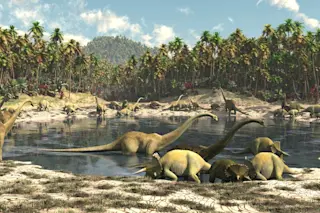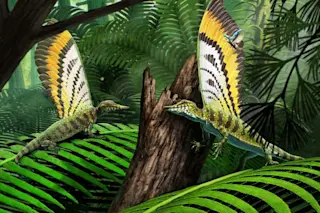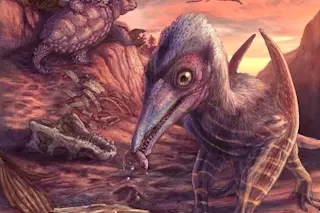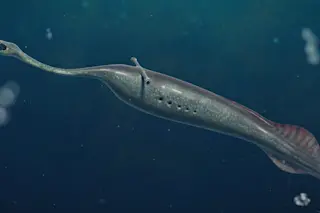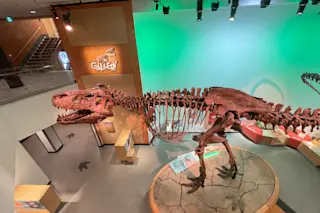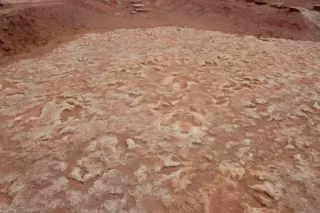Ever since Mary Higby Schweitzer peeked inside the fractured thighbone of a Tyrannosaurus rex, the introverted scientist's life hasn't been the same. Neither has the field of paleontology. Two years ago, Schweitzer gazed through a microscope in her laboratory at North Carolina State University and saw lifelike tissue that had no business inhabiting a fossilized dinosaur skeleton: fibrous matrix, stretchy like a wet scab on human skin; what appeared to be supple bone cells, their three-dimensional shapes intact; and translucent blood vessels that looked as if they could have come straight from an ostrich at the zoo.
By all the rules of paleontology, such traces of life should have long since drained from the bones. It's a matter of faith among scientists that soft tissue can survive at most for a few tens of thousands of years, not the 65 million since T. rex walked what's now the Hell Creek Formation in Montana. But Schweitzer tends to ignore such dogma. She just looks and wonders, pokes and prods, following her scientific curiosity. That has allowed her to see things other paleontologists have missed—and potentially to shatter fundamental assumptions about how much we can learn from the past. If biological tissue can last through the fossilization process, it could open a window through time, showing not just how extinct animals evolved but how they lived each day. "Fossils have richer stories to tell—about the lub-dub of dinosaur life—than we have been willing to listen to," says Robert T. Bakker, curator of paleontology at the Houston Museum of Natural Science. "This is one spectacular proof of that." At the same time, the contents of those T. rex bones have also electrified some creationists, who interpret Schweitzer's findings as evidence that Earth is not nearly as old as scientists claim. "I invite the reader to step back and contemplate the obvious," wrote Carl Wieland on the Answers in Genesis Web site last year. "This discovery gives immensely powerful support to the proposition that dinosaur fossils are not millions of years old at all, but were mostly fossilized under catastrophic conditions a few thousand years ago at most." Rhetoric like this has put Schweitzer at the center of a raging cultural controversy, because she is not just a pioneering paleontologist but also an evangelical Christian. That fact alone has prompted some prominent paleontologists to be even more skeptical about her scientific research. Some creationists have questioned her work from the other direction, pressing her to refute Darwinian evolution. But in her religious life, Schweitzer is no more of an ideologue than she is in her scientific career. In both realms, she operates with a simple but powerful consistency: The best way to understand the glory of the world is to open your eyes and take an honest look at what is out there. Reticent by nature, Schweitzer rarely grants interviews and shies away from making grand pronouncements about her scientific research or her religious faith. Instead of news stories about her stunning findings, she has adorned her office wall with a verse from the book of Jeremiah: "For I know the plans I have for you, declares the Lord, plans to prosper you and not to harm you, plans to give you hope and a future." Schweitzer's unconventional view of the fossilized past is rooted in her enduring sense of wonder. When she was 5, her older brother gave her a copy of Oliver Butterworth's The Enormous Egg, a fantasy that plays off the then-controversial notion of a close kinship between dinosaurs and birds. She became a dinosaur buff, but as so often happens, with adulthood her interests drifted in other directions. She spent summers selling snow cones and fireworks. She worked with deaf children. She earned an undergraduate degree in communicative disorders and a certificate in secondary education. In 1989, while dividing her time between substitute teaching and her three children, Schweitzer steered back toward her childhood fascination with dinosaurs. She approached Jack Horner, a renowned dinosaur scientist, and asked if she could audit his vertebrate paleontology course at Montana State University. He appreciated her refreshingly nontraditional mind. "She really wasn't much of a scientist—which is good," says Horner, curator of paleontology at the Museum of the Rockies. "Scientists all get to thinking alike, and it's good to bring people in from different disciplines. They ask questions very differently." Schweitzer's first forays into paleontology were "a total hook," she says. Not only was she fascinated by the science, but to her, digging into ancient strata seemed like reading the history of God's handiwork. Schweitzer worships at two churches—an evangelical church in Montana and a nondenominational one when she is back home in North Carolina—and when she talks about her faith, her bristly demeanor falls away. "God is so multidimensional," she says. "I see a sense of humor. I see His compassion in the world around me. It makes me curious, because the creator is revealed in the creation." Unlike many creationists, she finds the notion of a world evolving over billions of years theologically exhilarating: "That makes God a lot bigger than thinking of Him as a magician that pulled everything out in one fell swoop." Schweitzer's career began just as paleontologists started framing their own questions in more multidimensional ways. Until the 1980s, researchers were more likely to be trained in earth science than in biology. They often treated fossils as geologic specimens—mineral structures whose main value lay in showing the skeletal shapes of prehistoric animals. A younger generation of paleontologists, in contrast, has focused on reconstructing intimate details like growth rates and behaviors using modern techniques normally associated with the study of living organisms. "It's taking dinosaurs from being curious fossils to being biological entities," says Hans-Dieter Sues, associate director for research and collections at the Smithsonian's National Museum of Natural History in Washington, D.C. This shifting perspective clicked with Schweitzer's intuitions that dinosaur remains were more than chunks of stone. Once, when she was working with a T. rex skeleton harvested from Hell Creek, she noticed that the fossil exuded a distinctly organic odor. "It smelled just like one of the cadavers we had in the lab who had been treated with chemotherapy before he died," she says. Given the conventional wisdom that such fossils were made up entirely of minerals, Schweitzer was anxious when mentioning this to Horner. "But he said, 'Oh, yeah, all Hell Creek bones smell,'" she says. To most old-line paleontologists, the smell of death didn't even register. To Schweitzer, it meant that traces of life might still cling to those bones. She had already seen signs of exceptional preservation in the early 1990s, while she was studying the technical aspects of adhering fossil slices to microscope slides. One day a collaborator brought a T. rex slide to a conference and showed it to a pathologist, who examined it under a microscope. "The guy looked at it and said, 'Do you realize you've got red blood cells in that bone?' " Schweitzer remembers. "My colleague brought it back and showed me, and I just got goose bumps, because everyone knows these things don't last for 65 million years."
When Schweitzer showed Horner the slide, she recalls, "Jack said, 'Prove to me they're not red blood cells.' That was what I got my Ph.D. doing." She first ruled out contaminants and mineral structures. Then she analyzed the putative cells using a half-dozen techniques involving chemical analysis and immunology. In one test, a colleague injected rats with the dinosaur fossil extract; the rodents produced antibodies that responded to turkey and rabbit hemoglobins. All the data supported the conclusion that the T. rex fossil contained fragments of hemoglobin molecules. "The most likely source of these proteins is the once-living cells of the dinosaur," she wrote in a 1997 paper. That article, published in Proceedings of the National Academy of Sciences, sparked a small flurry of headlines. Horner and others regarded Schweitzer's research as carefully performed and credible. Nonetheless, says Horner, "most people were very skeptical. Frequently in our field people come up with new ideas, and opponents say, 'I just don't believe it.' She was having a hard time publishing in journals." Schweitzer was also stymied by her unconventional fusion of paleontology and molecular biology. "Those are two disciplines we don't usually see in the same sentence," says Lawrence Witmer, an Ohio University anatomy professor. Techniques that were routine in one discipline seemed odd when applied to the other. "If she was working with modern animals, there wouldn't be anything special about what she was doing," says Horner. But molecular paleontology was unheard-of. "It is a wide-open field that she invented," Horner says. Soldiering on with minimal funding, Schweitzer continued to hunt for the retention of living tissue longer than scientific theory might predict. When a group of fossil hunters found a cluster of preserved bird eggs in a city dump in Neuquén, Argentina, they originally believed the shells contained nothing but sand. Schweitzer placed the remains under scanning electron and atomic force microscopes and concluded that the 70-million-year-old eggs still held embryos containing intact collagen. For eight years, Schweitzer's career bobbed along with innovative but not attention-grabbing projects. Then she found that stretchy stuff inside a T. rex femur.
Schweitzer's breakthrough, like her early insight into the cadaverous odor of dinosaur bones, emerged from the fossil fields of the Hell Creek Formation, rugged badlands so remote that much of it lacks even unpaved roads. Tucked into Montana's northeast corner, Hell Creek was one of the last places on Earth dominated by dinosaurs before they became extinct. Horner's goal was to conduct a complete census of Hell Creek's dinosaur population—"just go out and collect everything," he says. In 2000, near one of his satellite camps, field crew chief Bob Harmon was eating lunch when he noticed a T. rex foot bone protruding from a sandstone cliff above his reach. Climbing a folding chair balanced on a pile of rocks, Harmon found another bone, then another, then another. By the time the team had excavated all the bones and encased them in plaster, the collection weighed 3,000 pounds, heavier than the helicopter could lift. With no other way to transport it, scientists reluctantly split the plaster jacket and broke the T. rex's 3.5-foot-long femur. In the process, the fossil bone shed some fragments. Workers wrapped them in aluminum foil and shipped them to North Carolina State University, where Schweitzer had just started teaching. "Jack just gave me the chunks and said, 'See what you can do with them,'" she recalls. Schweitzer, coping with culture shock and a recent divorce, had hit a lull in her research. "I wasn't out there soliciting new projects," she says. "I was trying to survive through each day." Her lab was still stacked with unpacked cartons when she opened the cardboard box from the T. rex dig and pulled out the biggest fragment. Looking at it with the eyes of a biologist, she immediately saw it was more than a fossil. Time and history began to unwind. "Oh, my gosh," she said to her laboratory assistant, Jennifer Wittmeyer. "It's a girl. And it's pregnant." What Schweitzer saw was medullary bone, a type of tissue that grows inside the long bones of female birds. Medullary bone is produced during ovulation as a way of storing the calcium needed for egg production; then it disappears. "I looked at it under the dissecting scope," Schweitzer says. "There was nothing else it could be." The medullary bone even contained gaps and mazelike fiber patterns resembling those of modern birds. Until that moment, no one had ever identified that tissue in a dinosaur, making it impossible to definitively sex such an animal. "Everything we've ever tried to do has been an utter guess," Schweitzer says. For instance, researchers had tried to distinguish a male from a female based on the shape of a creature's body or the size of its head crest. Now they had a way to link gender with morphology and, drawing on parallels with living animals, even with behavior. The second surprise hit in January 2004. While Schweitzer was attending a departmental taco party, Wittmeyer raced breathlessly into the room. "You aren't going to believe what happened," the lab assistant sputtered. Wittmeyer had been pulling the late shift, analyzing pieces from the T. rex limb. She had just soaked a fragment of medullary bone in dilute acid to remove some calcium phosphate. This was an unusual procedure to carry out in a dinosaur lab. Scientists typically assume that a fossilized dinosaur consists of rock that would entirely dissolve in acid, but Schweitzer wanted to get a closer look at the fossil's fine structure and compare it with that of modern birds. That night Wittmeyer marveled at a small section of decalcified thighbone: "When you wiggled it, it kind of floated in the breeze." Schweitzer and Wittmeyer pondered the meaning of the stretchy sample, feeling mystified and ecstatic. The remains seemed like soft tissue—specifically matrix, the organic part of bone, which consists primarily of collagen. Yet this seemed impossible, according to the prevailing understanding. "Everyone knows how soft tissues degrade," Schweitzer says. "If you take a blood sample and you stick it on a shelf, you have nothing recognizable in about a week. So why would there be anything left in dinosaurs?" Next Schweitzer examined a piece of the dinosaur's cortical bone. "We stuck the bone in the same kind of solution," she says. "The bone mineral dissolved away, and it left these transparent blood vessels. I took one look, and I just said: 'Uh-uh. This isn't happening. This is just not happening.' " She started applying the same treatment to bone fragments from another dinosaur that she had acquired for her dissertation. "Sure enough," she says, "vessels all over the place." Less than a month later, while Schweitzer was still collecting data on the soft tissue, came a third score. Wittmeyer walked into the lab looking anxious. "I think maybe some of our stuff's gotten contaminated, because I see these things floating around, and they look like bugs," she said. Worried that she would lose her dinosaur blood vessels before she could publish an article about them, Schweitzer rushed to rescue the sample. What she found startled her. Through the microscope she could see what looked like perfectly formed osteocytes, the cells inside bone. The past was roaring to life.
The ensuing avalanche of publicity, sometimes couched in breathless hyperbole ("Jurassic Park-type find could be first step in re-creating T. rex," huffed a story in the Ottawa Citizen), made her squeamish. She tried to ignore the media, but to no avail. Since the articles appeared, she has become one of the world's best-known paleontologists. Her findings challenge such basic assumptions about animal preservation that her colleagues have put her research—and the woman herself—under the microscope.
If soft tissue can last 65 million years, Horner says, "there may be a lot of things out there that we've missed because of our assumption of how preservation works." James Farlow, a paleontologist at Indiana University–Purdue University at Fort Wayne, adds, "If you can preserve soft tissue under these circumstances, all bets are off." Schweitzer's work opens the possibility of comparing dinosaur tissue with the tissue of living animals. It could also allow scientists to reconstruct ancient biology, such as prehistoric disease. If paleontologists encounter vascular channels in dinosaur fossils, they might also find nematodes, or roundworms, that lived off the animals' internal organs. "I'll bet you a six-pack of Coors that pretty soon people will be discovering Cretaceous parasites inside Cretaceous bones," says Bakker. "The possibility of looking into epidemiology and pathology is pretty cool."
On the flip side, Jeffrey Bada, an organic geochemist at the Scripps Institution of Oceanography in San Diego, cannot imagine soft tissue surviving millions of years. He says the cellular material Schweitzer found must be contamination from outside sources. Even if the T. rex had died in a colder, drier climate than Hell Creek, environmental radiation would have degraded its body, Bada says: "Bones absorb uranium and thorium like crazy. You've got an internal dose that will wipe out biomolecules." Others question Schweitzer's thoroughness. "The pictures were stunning, but the paper fell quite short," says Hendrik Poinar, a molecular evolutionary geneticist at McMaster University in Ontario. Schweitzer has not proved that the elastic tissue she found actually consists of molecules from the original dinosaur. Poinar ticks off a list of tests Schweitzer could have conducted, including searching for the building blocks of proteins and then sequencing them to determine their origin. "I understand you want to get your papers out quick and flashy," Poinar says, "but I'm more in favor of longer work with slam-dunk authenticity." Schweitzer agrees. "I am a slam-dunk scientist," she says. "I would have much rather held the paper back until we had reams and reams of data." But without publishing a journal article, she says, she could never have hoped for funding. "Without the papers in Science, I didn't stand a chance," she says. "That's the saddest part about doing science in America: You are totally driven by what gets you funding." Since publishing, Schweitzer has conducted many of the analyses Poinar suggests, with initially promising results. For a scientist, the ultimate test is having independent researchers replicate your results. So far, there hasn't been a mad rush to do so—few have expertise in both molecular biology and paleontology, not to mention the passion needed to carry out such work. But there is activity. Patrick Orr at University College Dublin is bringing together geologists and organic geochemists to look for soft tissue in a 10-million-year-old frog fossil. Paleontologists at the University of Chicago are setting up a laboratory to look for similar tissue in more T. rex remains; Horner is starting to decalcify other dinosaur bones. In the dinosaur lab at the Children's Museum of Indianapolis, Bakker has taken some peeks. "I haven't found anything yet," he says, "but wouldn't be a bit surprised if soon somebody comes up with more sticky, bouncy stuff." While scientists struggled to make sense of the bones, another community had no doubt about how to interpret the results. The reports were quickly embraced by biblical literalists who believe God created life on Earth less than 10,000 years ago. For decades they have been working to place a scientific patina on their ideas. The Institute for Creation Research runs a graduate school near San Diego with 11 instructors who hold doctorates in biochemistry, geology, and other sciences. Conferences offer papers on topics like the physics of the Genesis flood. "Any time there's empirical evidence, that's gold for them," says Ronald Numbers, a professor of the history of science and medicine at the University of Wisconsin at Madison. To Schweitzer, trying to prove your religious beliefs through empirical evidence is absurd, if not sacrilegious. "If God is who He says He is, He doesn't need us to twist and contort scientific data," she says. "The thing that's most important to God is our faith. Therefore, He's not going to allow Himself to be proven by scientific methodologies." Some creationists, noting Schweitzer's evangelical faith, have tried to pressure her into siding with them. "It is high time that the 'Scientific' community comes clean: meaning that the public is going to hold them ACCOUNTABLE when they find out that they have been misled," reads a recent e-mail message Schweitzer received. She has received dozens of similar notes, a few of them outright menacing. These religious attacks wound her far more than the scientific ones. "It rips my guts out," she says. "These people are claiming to represent the Christ that I love. They're not doing a very good job. It's no wonder that a lot of my colleagues are atheists." She told one zealot, "You know, if the only picture of Christ I had was your attitude towards me, I'd run." Ironically, the insides of Cretaceous-era dinosaur bones have only deepened Schweitzer's faith. "My God has gotten so much bigger since I've been a scientist," she says. "He doesn't stay in my boxes." Schweitzer's research doesn't stay within familiar boundaries either. Now there is no clear limit to how far science can go in bringing back the past. In particular, the letters DNA are never far from anyone's lips. "If there's preservation of cells, maybe there's preservation of the constituents of the cells," anatomist Lawrence Witmer says. "It could allow some of the molecular and genetic studies done on modern animals to be potentially used on dinosaur samples." Although scientists consider DNA unstable, in 2003 Schweitzer published a paper outlining several proposed ways the molecule might be preserved. For example, the degradation process itself might produce complex polymers that slow the DNA's further destruction. At the mention of DNA, minds race to science fiction depictions of cloned dinosaurs. In 2005 a Scottish newspaper announced that, thanks to Schweitzer's work, "scientists are a step closer to . . . bringing the most savage predator ever to walk the earth back from extinction." Even the National Science Foundation blurred the line. When it awarded Horner a grant to study T. rex blood cells years ago, the agency timed the announcement to coincide with the theatrical release of Jurassic Park. Schweitzer scoffs at visions of dinosaur parks. If anyone ever finds dinosaur DNA, she says, it will be fragmented and incomplete. In the unlikely event that scientists could reconstruct a complete dinosaur genome, she doubts that any modern animal could produce an egg capable of growing a dinosaur embryo. And even if that hurdle could be crossed, a viable dinosaur might not last long in 2006: "As far as we know, the way the lung tissue functioned, the way the hemoglobin functioned, was designed for an atmosphere that's very different than today's." Truth is, Schweitzer hasn't even bothered to look for DNA. She has simply hunkered down to work in her characteristic way: keeping her eyes and her attitude wide open. "So many things are coming together that suggest preservation is far better than we've ever given it credit for," she says. "I think it's stupid to say, 'You're never going to get DNA out of dinosaur bone, you're never going to get proteins out of dinosaur bone, you're never going to do this, you're never going to do that.' As a scientist, I don't think you should ever use the word never."


